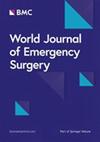Every minute counts: a network meta-analysis comparing the effect of prophylactic endovascular procedures in abnormal placentation
IF 5.8
1区 医学
Q1 EMERGENCY MEDICINE
引用次数: 0
Abstract
Preventing postpartum haemorrhage remains a high priority worldwide. We aimed to provide all available evidence comparing maternal and neonatal outcomes of different prophylactic endovascular procedures in patients with abnormal placentation. Pubmed, Embase and ClinicalTrials.gov databases were searched from inception to Nov, 2024, using relevant key words. Studies comparing outcomes of women undergoing or not prophylactic endovascular procedures in planned cesarean delivery in patients with antenatally suspected or confirmed PAS, placenta previa or both were included. An arm-based random effect frequentist network meta-analysis was performed. All available maternal and neonatal outcomes were evaluated. Three randomized controlled trials and 59 observational studies were eligible reporting on 6973 women (42.9% did not undergo any endovascular procedure, 26.7% underwent aortic balloon occlusion, REBOA, 16.6%, internal iliac balloon occlusion, PBO-IIA, 5.8%, common iliac artery occlusion, PBO-CIA, placement, and 7.8% underwent uterine artery embolization, UAE). The pooled network analysis showed that all prophylactic endovascular procedures were associated with reduced perioperative blood loss, with proximal balloon occlusion (REBOA) having the strongest effect (SMD −1.80 L, 95%CI −2.38;-1.21; I2 = 97.2%). Also, peripartum hysterectomy rates were significantly lower in women undergoing prophylactic UAE and REBOA compared to the control group; moreover, patients with placenta previa without any prophylactic endovascular procedure had a 4 to fivefold increased risk of peripartum hysterectomy compared to the REBOA group (I2 = 20.6%). REBOA was associated with a significant decrease in massive transfusion rates (I2 = 0%), surgery-related complications (I2 = 0%), ICU admissions (I2 = 40.3%), and units of red blood cells transfused (I2 = 92.8%), compared to PBO-IIA and control groups. The control group versus women undergoing prophylactic UAE showed a significant increase in total operative time (I2 = 96.5%) and Clavien-Dindo grade IV post-operative complications (I2 = 26%), compared to REBOA. All prophylactic endovascular procedures had a comparable risk ratio in terms of units of platelets transfused, maternal mortality, and use of additional post-operative bilateral uterine artery embolization among the treatment groups. As for neonatal outcomes, no significant differences were detected. Although the preponderance of observational studies suggests caution in interpreting the results of this meta-analysis, our findings suggest that prophylactic endovascular interventional procedures, particularly aortic balloon occlusion, may substantially improve clinical outcomes in women with PAS, placenta previa or both. CRD4202457398.每一分钟都很重要:一项网络荟萃分析,比较预防性血管内手术对异常胎盘的影响
预防产后出血仍然是全世界的一个高度优先事项。我们的目的是提供所有可用的证据,比较不同预防性血管内手术对异常胎盘患者的母婴结局。检索Pubmed、Embase和ClinicalTrials.gov数据库,检索时间为成立至2024年11月。研究比较了在产前怀疑或确诊PAS、前置胎盘或两者兼有的患者中接受或未接受预防性血管内手术的妇女在计划剖宫产中的结局。进行了基于臂的随机效应频率网络元分析。评估了所有可用的孕产妇和新生儿结局。3项随机对照试验和59项观察性研究纳入了6973名女性(42.9%未接受任何血管内手术,26.7%接受了主动脉球囊闭塞(REBOA), 16.6%接受了髂内球囊闭塞(PBO-IIA), 5.8%接受了髂总动脉闭塞(PBO-CIA), 7.8%接受了子宫动脉栓塞(UAE)。综合网络分析显示,所有预防性血管内手术均与减少围手术期出血量相关,其中近端球囊闭塞(REBOA)效果最强(SMD - 1.80 L, 95%CI - 2.38;i2 = 97.2%)。此外,与对照组相比,接受预防性UAE和REBOA的妇女围产期子宫切除术率显着降低;此外,与REBOA组相比,未进行任何预防性血管内手术的前置胎盘患者围产期子宫切除术的风险增加了4至5倍(I2 = 20.6%)。与PBO-IIA组和对照组相比,REBOA组大量输血率(I2 = 0%)、手术相关并发症(I2 = 0%)、ICU入院率(I2 = 40.3%)和输血红细胞单位数(I2 = 92.8%)显著降低。与REBOA相比,对照组与接受预防性UAE的妇女相比,总手术时间(I2 = 96.5%)和术后Clavien-Dindo IV级并发症(I2 = 26%)显著增加。在治疗组中,所有预防性血管内手术在血小板输注单位、产妇死亡率和术后额外双侧子宫动脉栓塞的使用方面具有相当的风险比。在新生儿结局方面,未发现显著差异。虽然观察性研究的优势提示在解释本荟萃分析的结果时要谨慎,但我们的研究结果表明预防性血管内介入手术,特别是主动脉球囊阻塞,可能会显著改善PAS、前置胎盘或两者兼有的女性的临床结果。CRD4202457398。
本文章由计算机程序翻译,如有差异,请以英文原文为准。
求助全文
约1分钟内获得全文
求助全文
来源期刊

World Journal of Emergency Surgery
EMERGENCY MEDICINE-SURGERY
CiteScore
14.50
自引率
5.00%
发文量
60
审稿时长
10 weeks
期刊介绍:
The World Journal of Emergency Surgery is an open access, peer-reviewed journal covering all facets of clinical and basic research in traumatic and non-traumatic emergency surgery and related fields. Topics include emergency surgery, acute care surgery, trauma surgery, intensive care, trauma management, and resuscitation, among others.
 求助内容:
求助内容: 应助结果提醒方式:
应助结果提醒方式:


